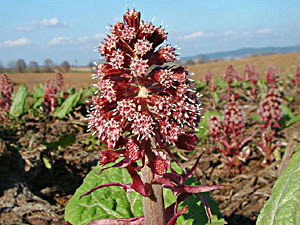
medicinal herbs
Butterbur
Petasites hybridus

Herb: Butterbur
Latin name: Petasites hybridus
Synonyms: Petasites officinalis, Petasites ovatus, Petasites vulgaris, Tussilago hybrida, Tussilago petasites
Family: Compositae
Medicinal use of Butterbur:
Butterbur is widely considered to be an effective cough remedy and recent experiments have shown it to have remarkable antispasmodic and pain-relieving properties. It acts specifically on the bile ducts, stomach and duodenum. The plant contains pyrrolizidine alkaloids, in isolation these are toxic to the liver. The root and the leaves are analgesic, antispasmodic, cardiotonic, diaphoretic and diuretic. A decoction is taken as a remedy for various respiratory problems such as asthma, colds, bronchitis and whooping cough and also other complaints such as fevers and urinary complaints. It is also very effective in the treatment of gastrointestinal complaints and biliary dyskinesia. Externally it can be used as a poultice to speed the healing of wounds and skin eruptions. The leaves are harvested in early summer, the root in late summer to autumn. Both can be dried for later use. Because the plant contains potentially toxic alkaloids its internal use cannot be recommended. A homeopathic remedy is made from the roots. It is used in the treatment of severe and obstinate neuralgia.Description of the plant:

Plant:
Perennial
Height:
100 cm(3 1/4 foot)

Flowering:
Marchto May
Habitat of the herb:
Wet meadows and copses by streams to 1500 metres. The female form is rare or absent from much of Britain.Propagation of Butterbur:
Seed - we have no information on this species but suggest sowing the seed in a cold frame as soon as it is ripe or in early spring. Only just cover the seed and do not allow the compost to dry out. When they are large enough to handle, prick the seedlings out into individual pots and plant them out in the summer. Division succeeds at almost any time of the year. Very easy, larger divisions can be planted out direct into their permanent positions. We have found that it is better to pot up the smaller divisions and grow them on in light shade in a cold frame until they are well established before planting them out in late spring or early summer.Cultivation of the herb:
Wet meadows and copses by streams to 1500 metres. The female form is rare or absent from much of Britain.Known hazards of Petasites hybridus:
None knownPlant information taken from the Plants For A Future.
